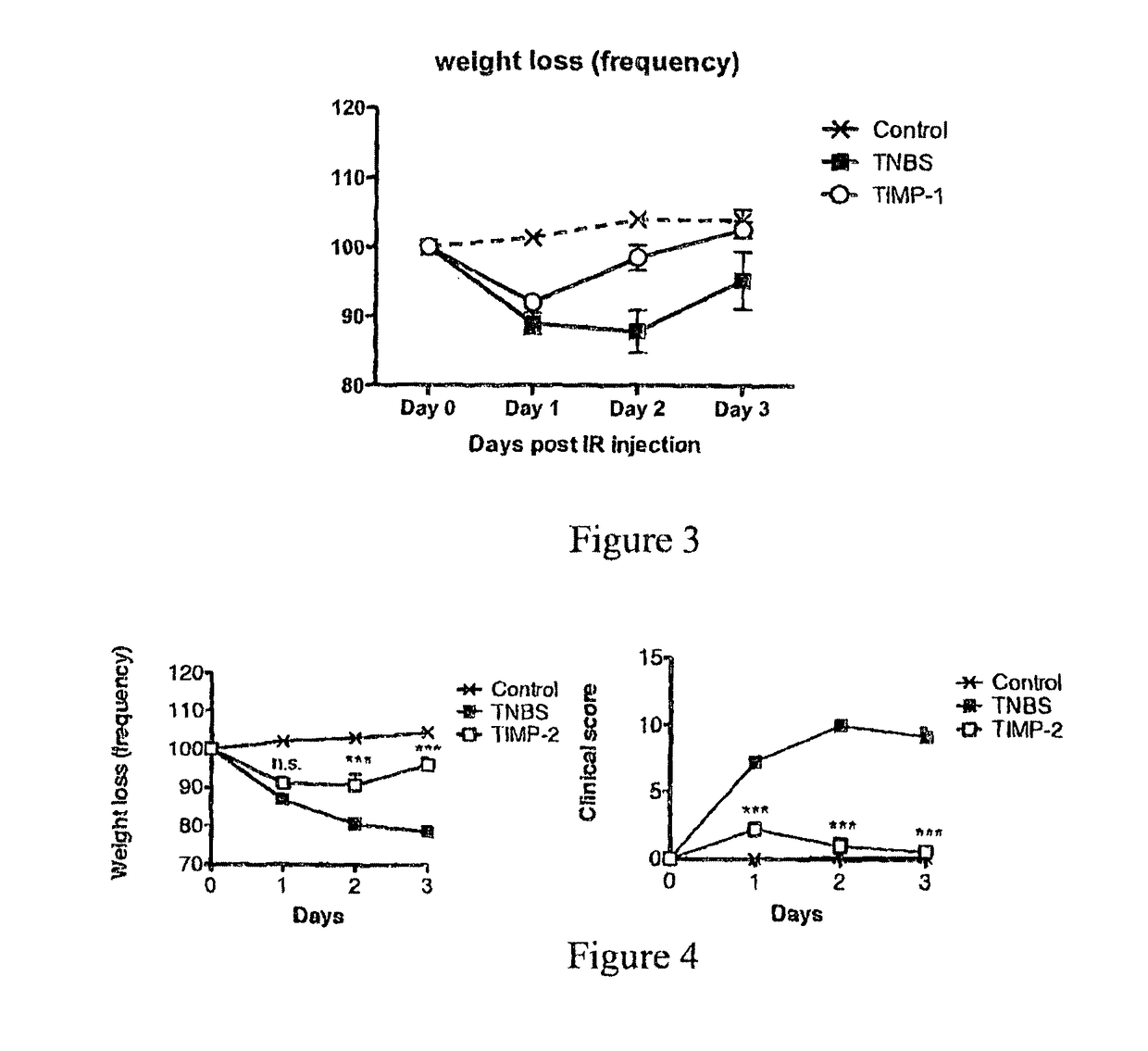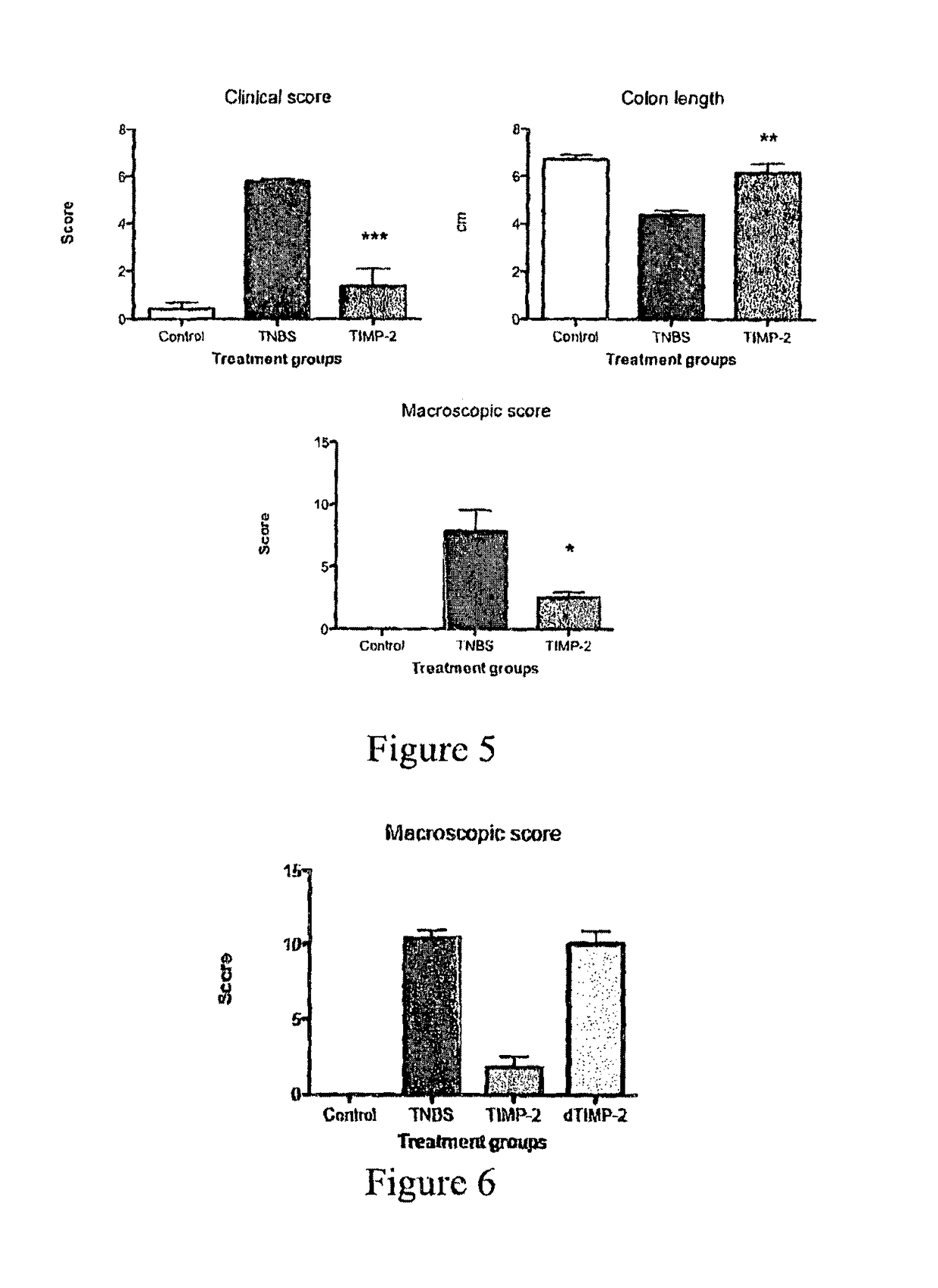Method for treating inflammation with an Ac-TMP-2 protein
a technology of ac and ac protein, applied in the field of inflammation treatment, can solve the problems of limitations in all directions, and achieve the effect of improving the permeability of the a
- Summary
- Abstract
- Description
- Claims
- Application Information
AI Technical Summary
Problems solved by technology
Method used
Image
Examples
example 1
Recombinant Ac-TMP-1 and Ac-TMP-2 Suppress IBD (TNBS Model)
Animals and TNBS-induced Colitis
[0119]Six week old male Swiss C57Bl / 6 mice (weight 20-25 g, Animal Resources Centre, Perth, Western Australia) were allowed to adapt for seven days before they were used in the experiments. They were housed according to Australian animal rights and regulations standards. All procedures involving mice were approved by the James Cook University Animal Ethics Committee.
[0120]Colitis was induced by intraluminal injection of TNBS as described by Neurath et al. (J Exp Med. 182:1281-90, 1995). Briefly, mice were fasted for 24 hours with free access to drinking water. They were anesthetized i.p. by a mixture of ketamine (50 μg / kg) and xylazine (5 μg / kg). Next, 100 μL of a 2.5 mg TNBS in 45% ethanol solution was injected intrarectally through a flexible catheter of 3.2 cm length. After TNBS injection, mice were held upside down in a 45° position for one minute to prevent leakage of the TNBS solution an...
example 2
Regulation of Experimental Asthma with Recombinant Ac-TMP-1
Animals and BSA-induced Asthma
[0123]Mice were sensitized with two intraperitoneal (i.p.) injections of 20 μg BSA in 2 mg of Aluminium hydroxide (Alum) on days 0 and 7. On days 14 to 21, mice were injected i.p. with 20 μg of either AcES or Ac-TMP-1. From days 18 to 21, mice were injected intranasally (i.n.) with 50 μg of BSA under a mild anaesthetic. On day 24, mice were sacrificed and tissue samples were collected.
Results
[0124]To investigate whether AcES or Ac-TMP-1 could prevent allergic airway inflammation in mice, BALB / c mice were treated daily with AcES or Ac-TMP-1 (20 μg i.p.) for four consecutive days before the challenge and four more days in concomitance to the challenge. Compared to the PBS mock injection group, AcES and Ac-TMP-1 treated mice exhibited a significantly reduced eosinophilia, perivascular and peribronchial cellular infiltration of the lungs (FIGS. 7 and 9). Compared to the naïve group, PBS-treated BSA-...
example 3
Regulation of Experimental Asthma with Recombinant Ac-TMP-1 / 2
Animals and OVA-induced Asthma
[0125]Sensitization was performed by two intraperitoneal (i.p.) injections of 20 μg of OVA in 2 mg of Aluminum hydroxide (Alum) (Pierce) at day 0 and 7. On days 14 to 21, mice were injected i.p. with 20 μg of either Ac-TMP-1 or Ac-TMP-2. From day 18 to 22, mice were exposed to OVA (0.25%) aerosols for 20 min using an ultrasonic nebulizer. Mice were analyzed on day 24.
[0126]On day 24, mice were sacrificed and bronchoalveolar lavages were collected. Cells were counted and stained with anti-Siglec F or anti-CCR3, anti-Gr1, anti-CD3, and anti-CD19 monoclonal antibodies and analysed by fluorescence-activated cell sorting (FACS) using a FACS canto II flow cytometer and FACS Diva software. Eosinophils were defined as CCR3+ or SiglecF+ CD3− CD19−, neutrophils as Gr-1high SiglecF−CD3−CD19−, lymphocytes as CD3+CD19+.
[0127]On day 24, mice were sacrificed and peritoneal lavages were collected. Briefly, th...
PUM
| Property | Measurement | Unit |
|---|---|---|
| weight | aaaaa | aaaaa |
| length | aaaaa | aaaaa |
| refractory | aaaaa | aaaaa |
Abstract
Description
Claims
Application Information
 Login to View More
Login to View More - R&D
- Intellectual Property
- Life Sciences
- Materials
- Tech Scout
- Unparalleled Data Quality
- Higher Quality Content
- 60% Fewer Hallucinations
Browse by: Latest US Patents, China's latest patents, Technical Efficacy Thesaurus, Application Domain, Technology Topic, Popular Technical Reports.
© 2025 PatSnap. All rights reserved.Legal|Privacy policy|Modern Slavery Act Transparency Statement|Sitemap|About US| Contact US: help@patsnap.com



